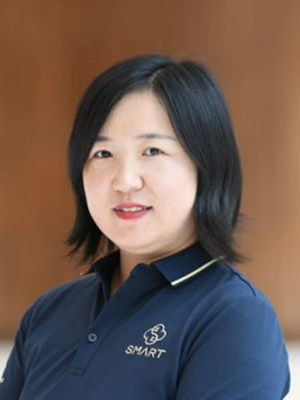
Principal Investigator
Structural Biology
panxj(at)smart.org.cn
Dr. Pan's work focuses on structural pharmacology of membrane proteins which are related with major diseases. She has published 5 articles as first author (including co-authors) in Science, and 7 articles as co-corresponding author in PNAS, Nature Communications and other leading journals.
2023 - PresentJunior Principal Investigator, Shenzhen Medical Academy of Research and Translation
2019 - 2023Research Associate Professor, School of Life Sciences, Tsinghua University, Beijing, China
2016 - 2019Postdoctoral Fellow, School of Medicine, Tsinghua University, Beijing, China
2011 - 2016PhD degree in the School of Medicine, Tsinghua University, Beijing, China
2007 - 2011BS degree in the School of Life Sciences, the University of Science and Technology of China
2021 National Postdoctoral Program for Innovative Talents from China Postdoctoral Science Foundation
2019 Distinguished Young Researcher Program from Beijing Municipal Science & Technology Commission
2019 Advanced Innovation Fellow, Beijing Advanced Innovation Center for Structural Biology
2018 The Outstanding Postdoc Fellowship of Tsinghua University
2016 National Postdoctoral Program for Innovative Talents from China Postdoctoral Science Foundation
2016 Outstanding Graduate of Beijing
2013 National Scholarshiop for Graduate Student from the Ministry of Education of China
2012 National Scholarshiop for Graduate Student from the Ministry of Education of China
2012 The Seventeenth Scholarship for Excellent Doctoral Student from the Ministry of Education of China
2012 Jiang Nanxiang Scholarship of Tsinghua University
2011 Outstanding Graduate of Anhui Province; Outstanding Graduate of the University of Science and Technology of China
* for co-author; #for co-corresponding author.
1.Wu, Q.*, Huang, J.*#, Fan, X.*#, Wang, K.*, Jin, X., Huang, G., Li, J., Pan, X.# and Yan, N.#, 2023. Structural mapping of Nav1. 7 antagonists. Nature Communications, 14(1), p.3224.
2.Huang, G.*, Wu, Q.*, Li, Z.*, Jin, X.*, Huang, X., Wu, T., Pan, X.#and Yan, N.#, 2022. Unwinding and spiral sliding of S4 and domain rotation of VSD during the electromechanical coupling in Nav1. 7. Proceedings of the National Academy of Sciences, 119(33), p.e2209164119.
3.Huang, X.*, Jin, X.*, Huang, G., Huang, J., Wu, T., Li, Z., Chen, J., Kong, F., Pan, X.# and Yan, N.#, 2022. Structural basis for high-voltage activation and subtype-specific inhibition of human Nav1. 8. Proceedings of the National Academy of Sciences, 119(30), p.e2208211119.
4.Pan, X.*#, Li, Z.*, Jin, X.*, Zhao, Y.*, Huang, G.*, Huang, X., Shen, Z., Cao, Y., Dong, M., Lei, J. and Yan, N.#, 2021. Comparative structural analysis of human Nav1. 1 and Nav1. 5 reveals mutational hotspots for sodium channelopathies. Proceedings of the National Academy of Sciences, 118(11), p.e2100066118.
5.Li, Z., Jin, X., Wu, T., Zhao, X., Wang, W., Lei, J., Pan, X.# and Yan, N.#, 2021. Structure of human Nav1. 5 reveals the fast inactivation-related segments as a mutational hotspot for the long QT syndrome. Proceedings of the National Academy of Sciences, 118(11), p.e2100069118.
6.Shen, H.#, Yan, N.# and Pan, X.#, 2021. Structural determination of human Nav1. 4 and Nav1. 7 using single particle cryo-electron microscopy. Methods in Enzymology (Vol. 653, pp. 103-120). Academic Press.
7.Chi, X.*, Jin, X.*, Chen, Y.*, Lu, X., Tu, X., Li, X., Zhang, Y., Lei, J., Huang, J., Huang, Z.#, Zhou, Q.#, and Pan, X.#, 2020. Structural insights into the gating mechanism of human SLC26A9 mediated by its C-terminal sequence. Cell Discovery, 6(1), p.55.
8.Pan, X.*, Li, Z.*, Huang, X.*, Huang, G.*, Gao, S., Shen, H., Liu, L., Lei, J. and Yan, N., 2019. Molecular basis for pore blockade of human Na+ channel Nav1. 2 by the μ-conotoxin KIIIA. Science, 363(6433), pp.1309-1313.
9.Pan, X.*, Li, Z.*, Zhou, Q.*, Shen, H.*, Wu, K.*, Huang, X., Chen, J., Zhang, J., Zhu, X., Lei, J. and Xiong, W., Gong, H., Xiao, B., and Yan, N., 2018. Structure of the human voltage-gated sodium channel Nav1. 4 in complex with β1. Science.362(6412), p.eaau2486.
10.Shen, H.*, Li, Z.*, Jiang, Y.*, Pan, X.*, Wu, J., Cristofori-Armstrong, B., Smith, J.J., Chin, Y.K., Lei, J., Zhou, Q.# and King, G.F.#, and Yan, N.#, 2018. Structural basis for the modulation of voltage-gated sodium channels by animal toxins. Science, 362(6412), p.eaau2596.
11.Shen, H.*, Zhou, Q.*, Pan, X.*, Li, Z.*, Wu, J. and Yan, N., 2017. Structure of a eukaryotic voltage-gated sodium channel at near-atomic resolution. Science, 355(6328), p.eaal4326.
12.Deng, D.*, Yan, C.*, Pan, X.*, Mahfouz, M., Wang, J., Zhu, J.K., Shi, Y.# and Yan, N.#, 2012. Structural basis for sequence-specific recognition of DNA by TAL effectors. Science, 335(6069), pp.720-723.